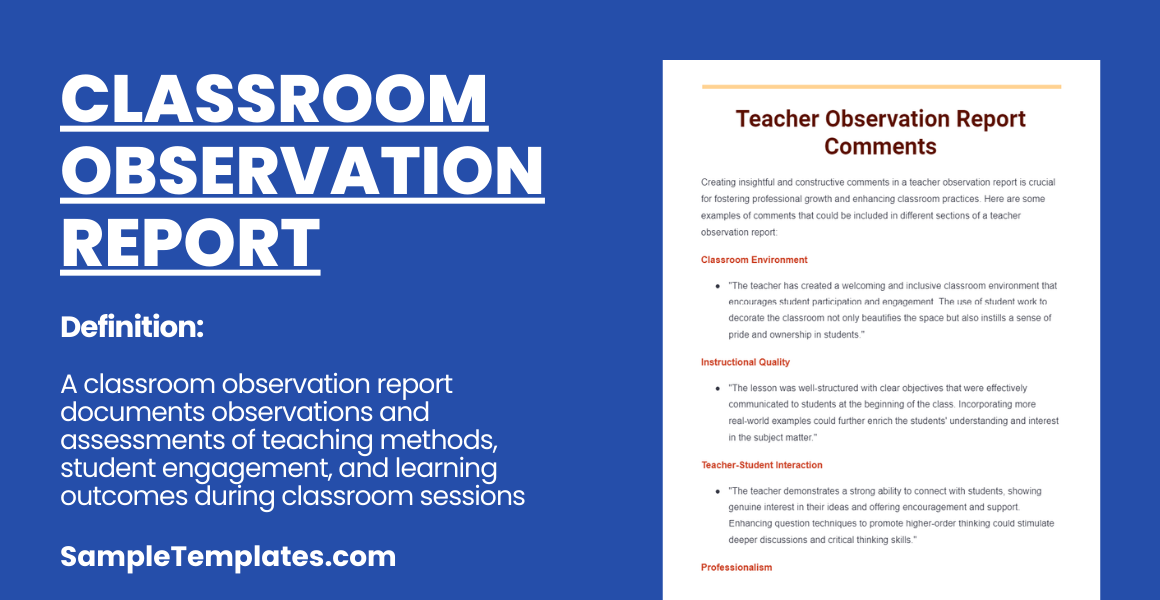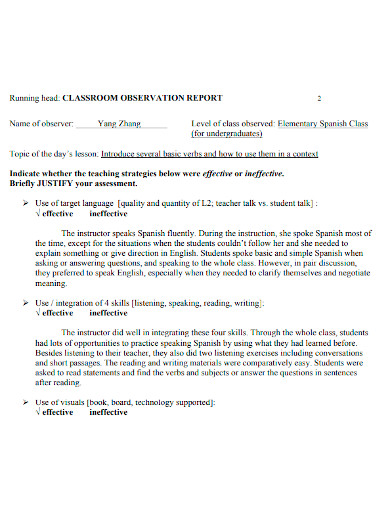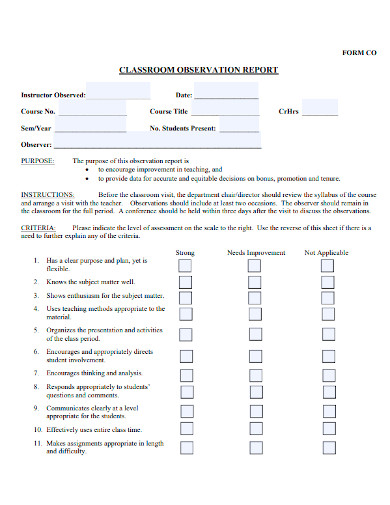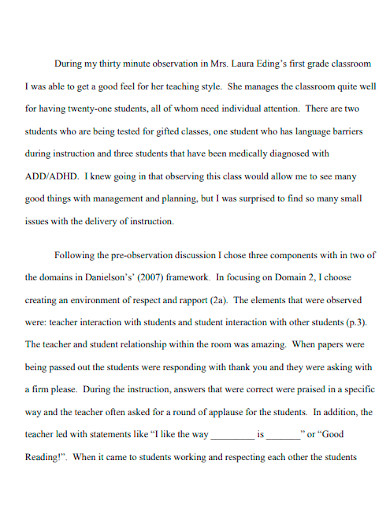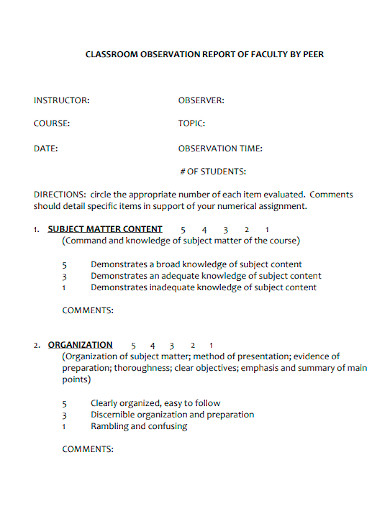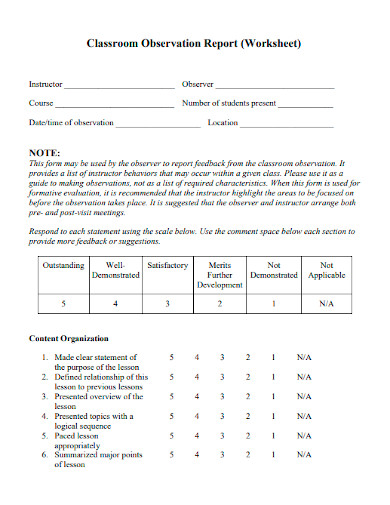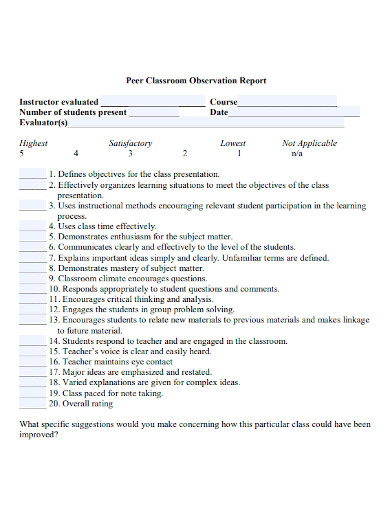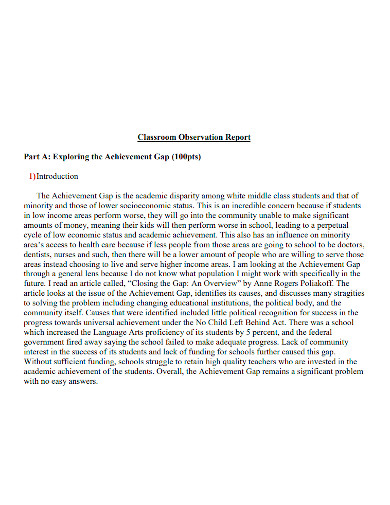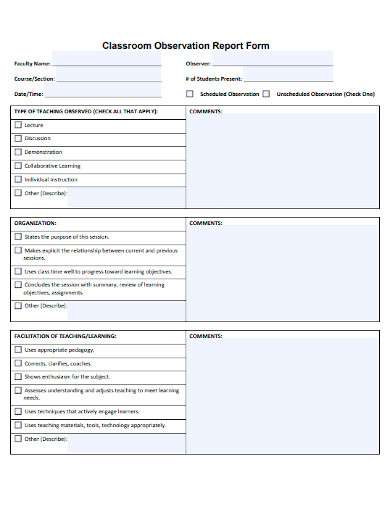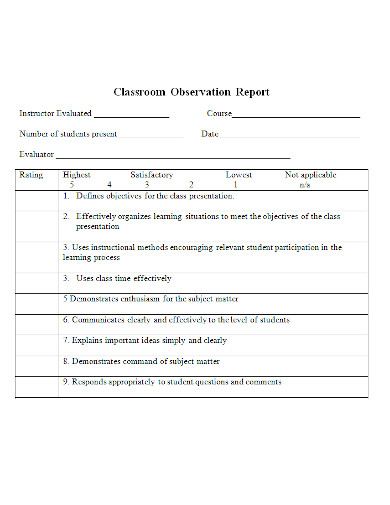The most important role in a classroom management setting is of course the role of what a teacher does to the students. The teacher’s role goes beyond imparting knowledge and evaluating the capacity of each of their students but more importantly, how they make the experience of being at school and studying a valuable experience in life. With that, teachers should also be calibrated with the standards set by the school and how they deal with their students. One of the most effective ways to do this is to conduct a classroom observation and make a report out of it.
What is the significance of conducting a classroom observation? What can it do to improve the teaching styles of a teacher? If you’re one who is tasked with making a report on classroom observation, you can download the free classroom observation reports samples on this page to guide you. Read on.
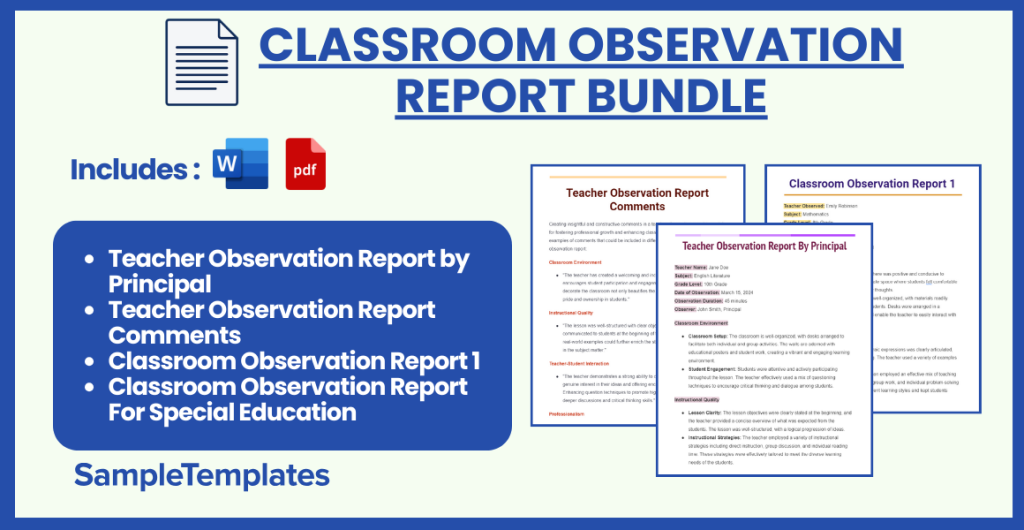
Download Classroom Observation Report Bundle
Teacher Observation Report by Principal
Teacher Name: Jane Doe
Subject: English Literature
Grade Level: 10th Grade
Date of Observation: March 15, 2024
Observation Duration: 45 minutes
Observer: John Smith, Principal
Classroom Environment
- Classroom Setup: The classroom is well-organized, with desks arranged to facilitate both individual and group activities. The walls are adorned with educational posters and student work, creating a vibrant and engaging learning environment.
- Student Engagement: Students were attentive and actively participating throughout the lesson. The teacher effectively used a mix of questioning techniques to encourage critical thinking and dialogue among students.
Instructional Quality
- Lesson Clarity: The lesson objectives were clearly stated at the beginning, and the teacher provided a concise overview of what was expected from the students. The lesson was well-structured, with a logical progression of ideas.
- Instructional Strategies: The teacher employed a variety of instructional strategies including direct instruction, group discussion, and individual reading time. These strategies were effectively tailored to meet the diverse learning needs of the students.
- Content Knowledge: The teacher demonstrated a deep understanding of English Literature, effectively conveying complex concepts in an accessible manner. Their passion for the subject matter was evident and infectious.
Teacher-Student Interaction
- Classroom Management: Classroom rules were clearly communicated and consistently enforced, creating a respectful and orderly learning environment. The teacher effectively managed transitions and kept students on task.
- Student Support: The teacher was attentive to students’ needs, offering individual support during independent work periods. They provided constructive feedback, praising students’ efforts and guiding them towards improvement.
Professionalism
- Preparation: The teacher was well-prepared for the lesson, with all materials and resources ready at the start of the class. Their planning was evident in the smooth execution of the lesson plan.
- Professional Development: The teacher demonstrates a commitment to professional growth, incorporating new teaching methods and technologies into their instructional practice.
Recommendations for Improvement
- Differentiated Instruction: While the teacher employs a variety of teaching strategies, further differentiation could enhance learning for all students. Tailoring tasks to meet individual learning styles and levels can increase engagement and achievement.
- Technology Integration: Incorporating more technology-based activities could further engage students and provide additional avenues for exploration and learning. Tools such as interactive presentations or online discussion boards could complement traditional teaching methods.
Overall Assessment
Jane Doe is a dedicated and effective teacher who creates a positive and stimulating learning environment for her students. Her strong content knowledge, combined with her enthusiasm for teaching, makes her a valuable asset to our school. By focusing on continuous improvement and incorporating the suggested enhancements, she has the potential to further elevate her teaching practice.
Observer Signature: John Smith
Date: March 16, 2024
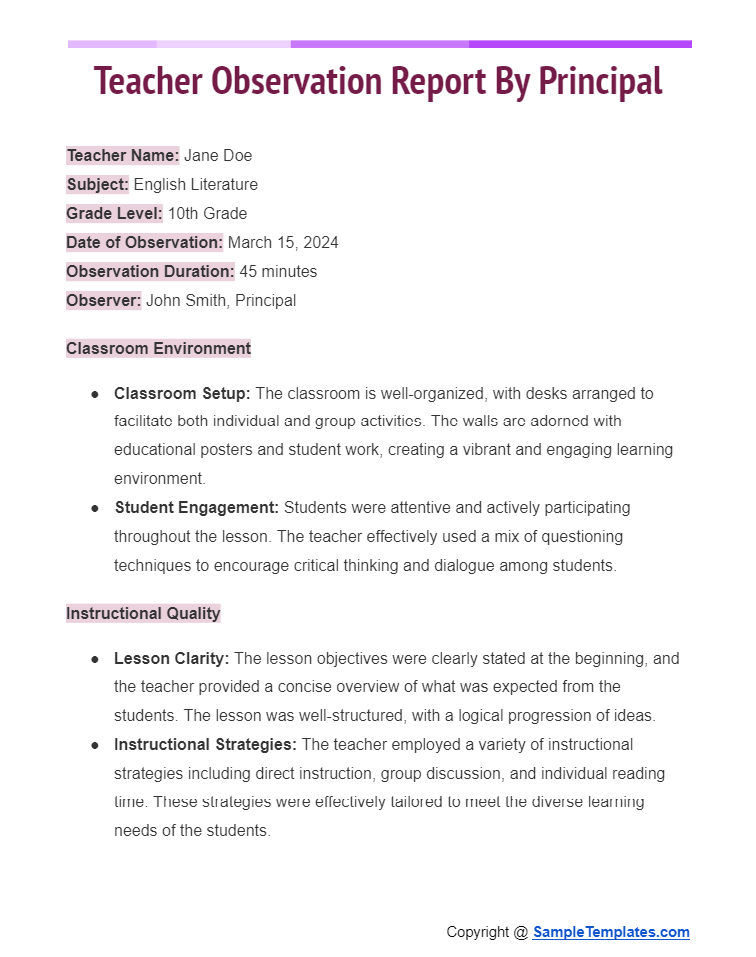
Teacher Observation Report Comments
Creating insightful and constructive comments in a teacher observation report is crucial for fostering professional growth and enhancing classroom practices. Here are some examples of comments that could be included in different sections of a teacher observation report:
Classroom Environment
- “The teacher has created a welcoming and inclusive classroom environment that encourages student participation and engagement. The use of student work to decorate the classroom not only beautifies the space but also instills a sense of pride and ownership in students.”
Instructional Quality
- “The lesson was well-structured with clear objectives that were effectively communicated to students at the beginning of the class. Incorporating more real-world examples could further enrich the students’ understanding and interest in the subject matter.”
Teacher-Student Interaction
- “The teacher demonstrates a strong ability to connect with students, showing genuine interest in their ideas and offering encouragement and support. Enhancing question techniques to promote higher-order thinking could stimulate deeper discussions and critical thinking skills.”
Professionalism
- “The teacher is highly prepared and organized, which is evident in the seamless flow of the lesson and the efficient use of class time. Continuing to seek out professional development opportunities, especially in the area of educational technology, could further enhance instructional practices.”
Classroom Management
- “Classroom management is a strength, with the teacher maintaining a learning environment that is respectful and focused. Exploring additional strategies for engaging students who show signs of disinterest or distraction could ensure that all students remain engaged throughout the lesson.”
Engagement Strategies
- “The teacher effectively uses a variety of engagement strategies to keep students interested in the lesson. Incorporating student-led teaching opportunities could empower students and give them a more active role in their learning process.”
Feedback and Assessment
- “Feedback provided to students is timely, constructive, and specific, which supports learning and improvement. Implementing more formative assessment techniques could provide both the teacher and students with more immediate insights into their understanding and progress.”
Recommendations for Future Observations
- “For future observations, it would be beneficial to focus on the integration of technology in the classroom to enhance interactive learning. Additionally, observing how differentiated instruction strategies are applied to meet the diverse needs of students could offer valuable insights.”
Including comments like these in a teacher observation report can provide actionable feedback that supports teachers in their professional development, aiming to enrich their instructional methods and enhance student learning outcomes.
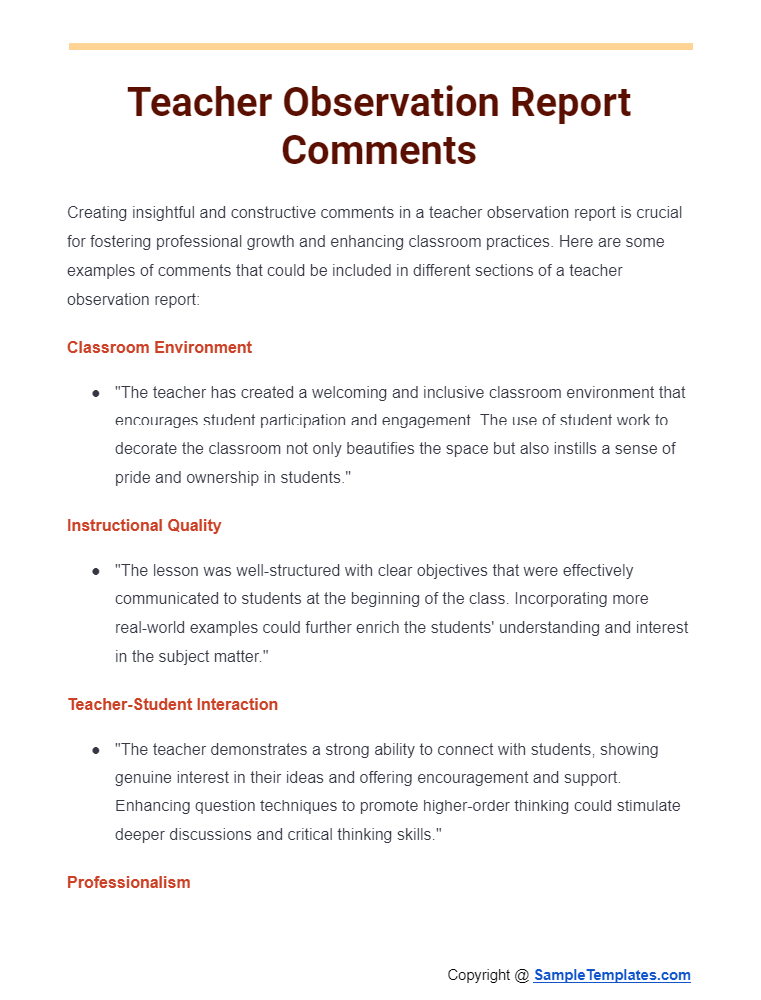
Classroom Observation Report 1
Teacher Observed: Emily Robinson
Subject: Mathematics
Grade Level: 8th Grade
Date of Observation: March 20, 2024
Observation Duration: 1 hour
Observer: Alex Martinez, Assistant Principal
Classroom Environment
- Atmosphere: The classroom atmosphere was positive and conducive to learning. The teacher has created a safe space where students felt comfortable asking questions and expressing their thoughts.
- Physical Setup: The classroom was well-organized, with materials readily accessible to both the teacher and students. Desks were arranged in a semi-circle to facilitate discussion and enable the teacher to easily interact with each student.
Lesson Delivery
- Lesson Clarity: The lesson on algebraic expressions was clearly articulated, with objectives stated at the beginning. The teacher used a variety of examples to ensure concepts were understood.
- Instructional Strategies: Ms. Robinson employed an effective mix of teaching methods, including direct instruction, group work, and individual problem-solving activities. This variety catered to different learning styles and kept students engaged.
- Pacing: The lesson was well-paced, allowing time for in-depth explanation, student practice, and review of key concepts. The teacher was adept at adjusting the pace based on student understanding.
Teacher-Student Interaction
- Engagement: Students were highly engaged throughout the lesson, participating actively in discussions and eagerly tackling practice problems. The teacher’s enthusiasm for mathematics was contagious.
- Feedback: The teacher provided immediate and specific feedback, praising correct answers and gently correcting mistakes. She encouraged students to explain their thought processes, fostering a deeper understanding.
- Classroom Management: Classroom management was effective, with minimal disruptions. The teacher maintained a respectful and orderly environment, addressing any issues quickly and calmly.
Professionalism and Communication
- Professionalism: Ms. Robinson displayed a high level of professionalism, demonstrating thorough knowledge of the subject matter and a strong commitment to student learning.
- Communication: Clear and effective communication was evident both in interactions with students and in the presentation of material. Instructions were clear, and explanations were detailed and accessible.
Areas for Development
- Differentiated Instruction: While the lesson was well-executed, incorporating more differentiated instruction strategies could help address the needs of all learners, especially those who may require additional challenges or support.
- Technology Integration: Exploring the use of technology tools, such as educational apps or interactive whiteboards, could enhance lesson engagement and offer diverse ways to explore mathematical concepts.
Overall Assessment
Emily Robinson is a dedicated and effective educator who creates an engaging and supportive learning environment. Her passion for mathematics and commitment to student success are evident. By expanding the use of differentiated instruction and integrating technology into lessons, she can further enhance her teaching practice and student learning outcomes.
Observer Signature: Alex Martinez
Date: March 21, 2024
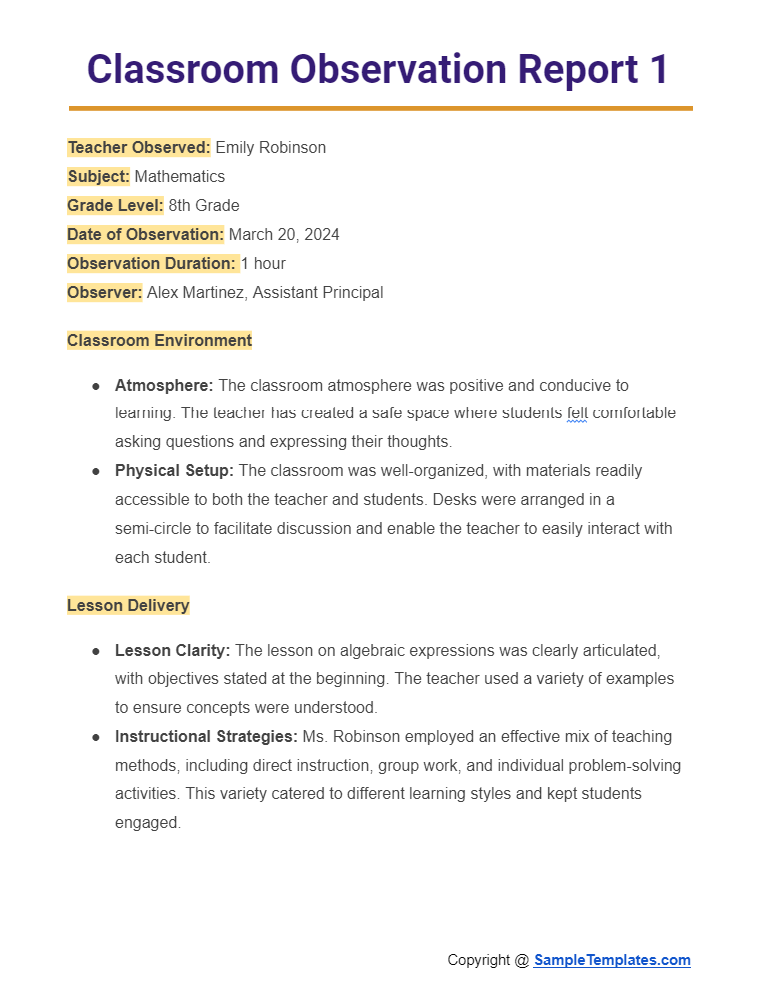
Classroom Observation Report For Special Education
Teacher Observed: Sarah Jennings
Subject Area: Special Education – Mixed Subjects
Grade Level: Mixed Ages (Elementary)
Date of Observation: March 25, 2024
Observation Duration: 1 hour
Observer: Michael Thompson, Special Education Coordinator
Classroom Environment
- Atmosphere: The classroom atmosphere was warm, inviting, and structured, providing a safe and supportive environment for all students. Mrs. Jennings has created a space that respects and celebrates the unique needs and abilities of each student.
- Physical Setup: The classroom layout was thoughtfully arranged to accommodate the diverse needs of students, with clear pathways for mobility and zones designated for different activities (e.g., individual work, group sessions, sensory area). Visual schedules and labels were prominently displayed to aid understanding and independence.
Instructional Strategies
- Adaptation and Modification: Mrs. Jennings skillfully adapted lesson content and materials to meet the varied learning needs of her students. She used a combination of tactile, visual, and auditory resources to ensure content accessibility.
- Engagement and Interaction: High levels of engagement were observed, with students actively participating in tailored activities. Mrs. Jennings fostered a positive interaction among students, encouraging peer support and collaboration.
- Differentiation: Each activity was differentiated to cater to individual student goals and IEP (Individualized Education Program) objectives. This personalized approach allowed students to work at their own pace and level of ability.
Teacher-Student Interaction
- Communication: Effective use of alternative and augmentative communication (AAC) devices and sign language ensured that all students could communicate their needs and participate in lessons. Mrs. Jennings demonstrated patience and attentiveness to understanding each student’s mode of communication.
- Behavior Management: Positive behavior reinforcement strategies were consistently applied, contributing to a respectful and focused classroom environment. Mrs. Jennings used clear, consistent expectations and visual cues to guide student behavior.
Professionalism and Support
- Collaboration with Specialists: Mrs. Jennings actively collaborated with speech therapists, occupational therapists, and other specialists during the observation period, integrating their recommendations into classroom activities to support holistic student development.
- Family Engagement: It was noted that Mrs. Jennings maintains strong communication with families, providing regular updates on student progress and strategies for home reinforcement.
Areas for Development
- Technology Integration: Further integration of assistive technology could enhance learning experiences, particularly for students with complex communication needs. Exploring new tools and software could provide additional avenues for engagement and expression.
- Professional Development: Pursuing additional professional development opportunities in emerging special education practices and technologies could further enhance Mrs. Jennings’s already effective teaching strategies.
Overall Assessment
Sarah Jennings is a highly skilled and compassionate special education teacher who excels in creating a learning environment that addresses the comprehensive needs of her students. Her dedication to adapting instructional strategies and materials for diverse learners is commendable. By continuing to explore new technologies and professional development opportunities, Mrs. Jennings can further enrich her teaching practice and student learning outcomes.
Observer Signature: Michael Thompson
Date: March 26, 2024
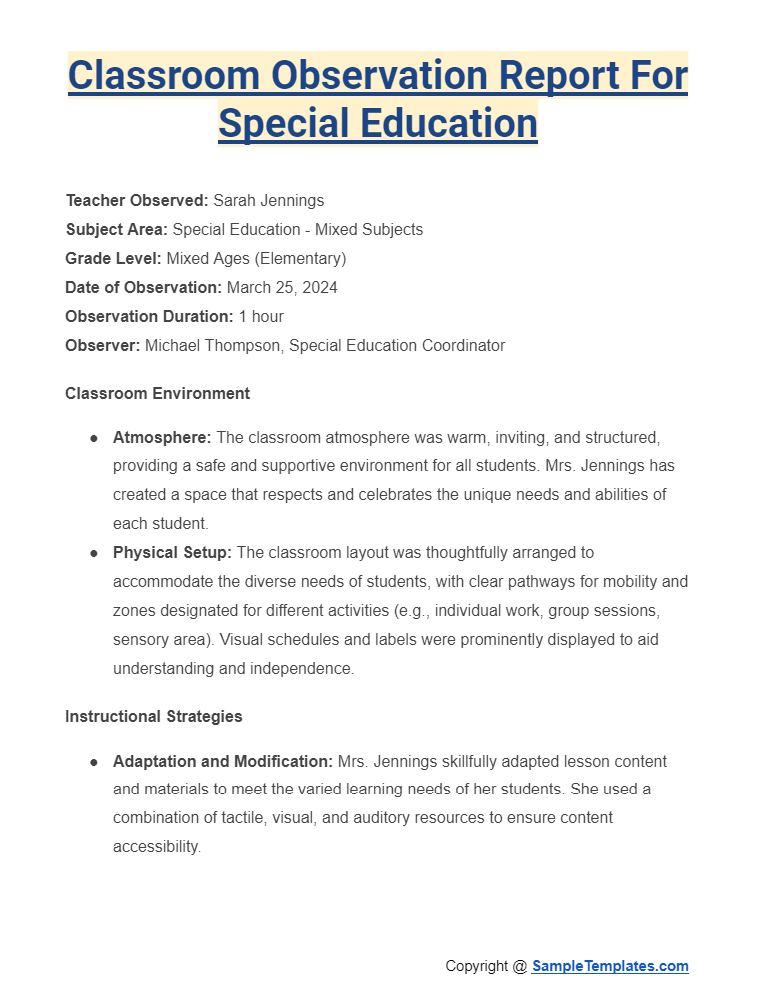
Browse More Templates On Classroom Observation Report
Classroom Observation Report
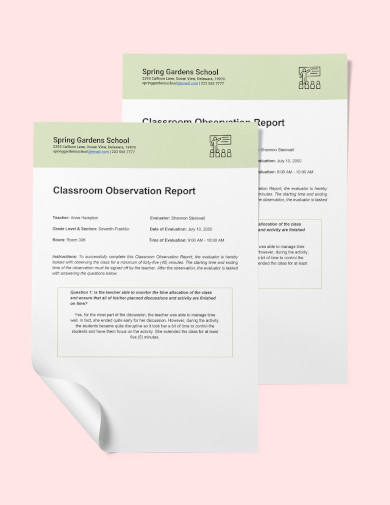
Observation Report Sample
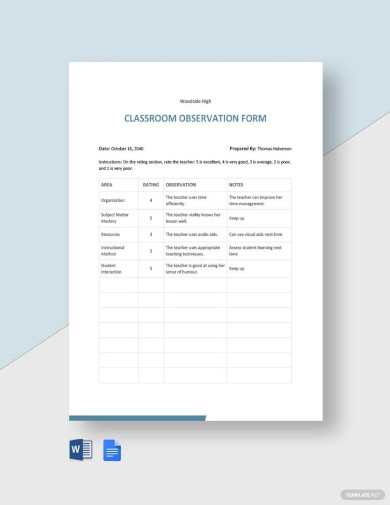
Teacher Classroom Observation Report Sample
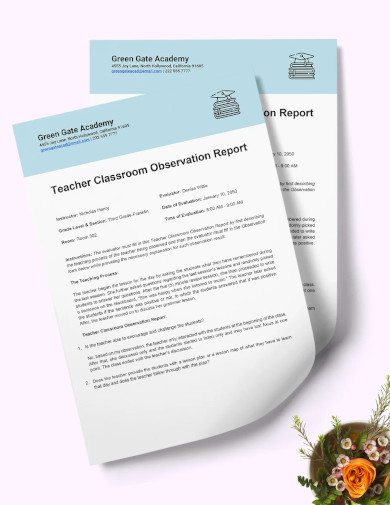
Classroom Observation Report Sample PDF
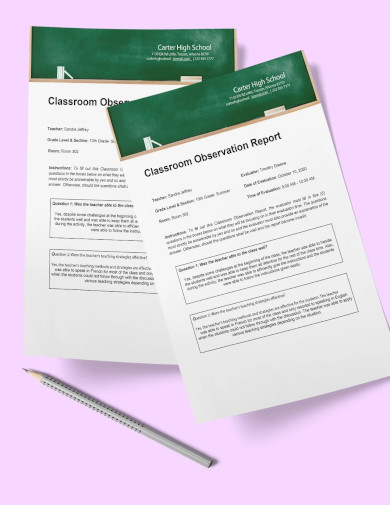
Student Observation Report Sample
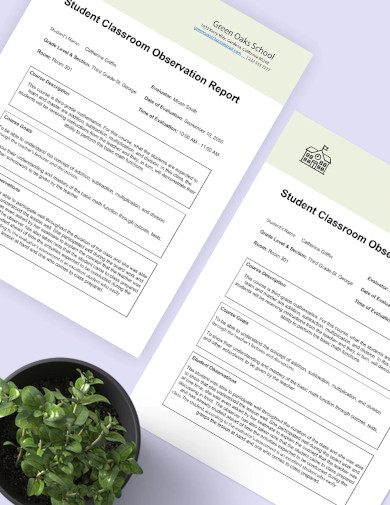
Class Observation Report Sample
How Do You Write an Observation Note in a Classroom?
To write an observation note in a classroom:
- Date and Time: Record the date and time of the observation.
- Focus: Specify the area of focus (e.g., student interaction, teacher’s methods).
- Objective Details: Note specific behaviors, interactions, or teaching methods observed.
- Quotes or Examples: Include direct quotes or examples to support observations.
- Positive Notes: Acknowledge strengths and effective strategies observed.
- Areas for Improvement: Highlight any areas that could be enhanced or developed.
- Reflection: Provide personal insights or reflections on the observed session.
- Next Steps: Recommend action points or follow-up observations if necessary.
- Maintain Confidentiality: Ensure the confidentiality of student and teacher information.
Classroom Report Sample
Classroom Observation Report Example
Teachers Observation Report Format
Class Observation Report Format
What is an Example of an Observation in the Classroom?
An observation in a classroom might involve noting how students engage during group activities. For instance, observing how they collaborate, communicate, or solve problems in a team setting provides insights into their social skills and learning dynamics. It could involve recording their interactions, problem-solving approaches, and the level of participation of each student. The observation might reveal leadership qualities, collaboration styles, or areas where some students may need more encouragement or support. This type of observation helps assess both individual and group dynamics, offering valuable insights into student behavior and learning outcomes.
Class Report Sample
Observation Class Report Sample
Why is Classroom Observation Important?
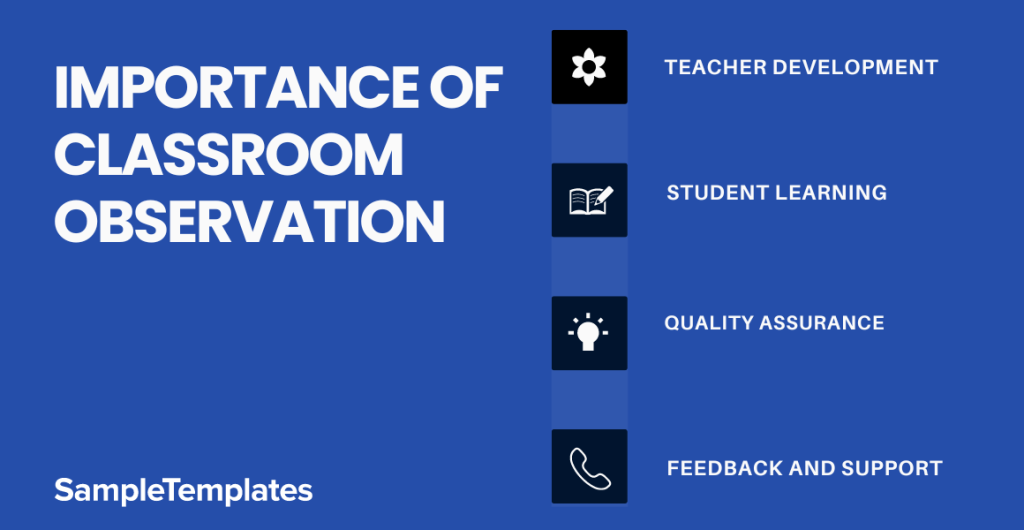
Classroom observation is crucial for several reasons:
- Teacher Development: It helps educators refine their teaching methods, identify strengths, and address weaknesses.
- Student Learning: Observations enhance understanding of how students engage and learn, enabling tailored teaching approaches.
- Assessment of Strategies: It assesses the effectiveness of instructional strategies and curriculum implementation.
- Professional Growth: Supports ongoing teacher development, encouraging reflective practices and continuous improvement.
- Quality Assurance: Offers insights for school administrators to maintain teaching standards and improve overall education quality.
- Feedback and Support: Provides constructive feedback and support for teachers, fostering a culture of collaboration and growth.
Observation Report PDF
Classroom Teaching Observation Report
What are the 4 Types of Observation?
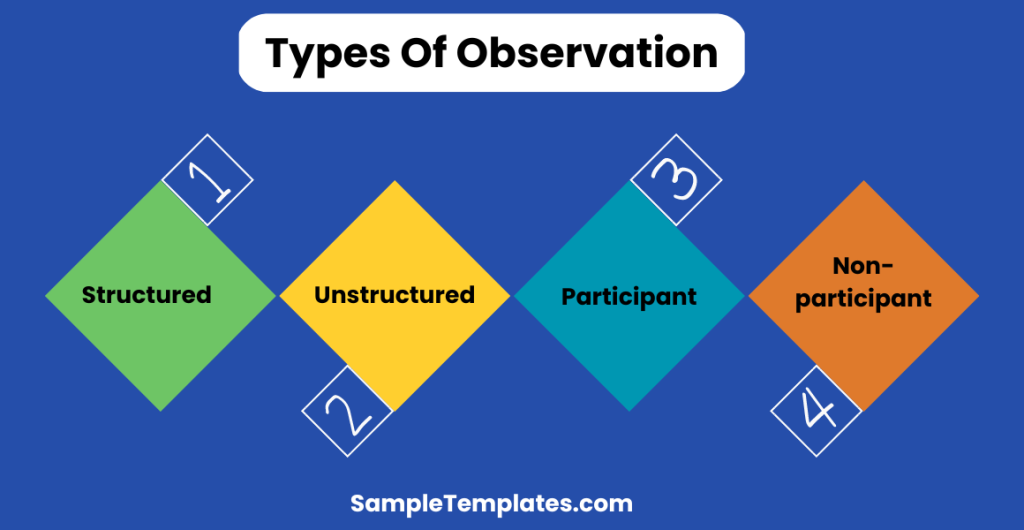
- Structured Observation: Involves predetermined criteria, specific behaviors, or a checklist to guide the observation.
- Unstructured Observation: Open-ended, allowing the observer to note any behavior or activity without predefined criteria.
- Participant Observation: The observer becomes part of the group being observed, participating in activities while noting behaviors.
- Non-participant Observation: The observer remains separate from the group being observed, simply watching and recording behaviors.
Elementary Classroom Observation Report Sample
Editable Classroom Observation Report
The Importance of Classroom Observation
1. Analyzing current instructional processes
One of the most important purposes of conducting a classroom observation is to dissect the current status of instructional processes that is part of the teaching standard operating procedures set by the school. At the time of observation, the teachers knowing the school’s format in delivering lectures, and student evaluation are expected to act accordingly.
If such standards are properly executed, this is where the observer does the evaluation of the quality of the teacher’s teaching style against the school’s standards. By doing this, the school will be able to point out which parts of their instructional standards are difficult to execute or are disadvantageous to the part of the teachers. Also, the complexity of such standards will go through management evaluation to determine if it is vital to the learning of its students and to the school’s development.
2. Inequality experienced by students
Another reason why classroom observation is vital to the development of higher education lesson plans is that it discovers the inequalities that may exist in the classroom towards the other student. It may be that such inequalities are not directly seen during the actual classroom observation but it can be implied with the evaluation of some students to the teaching style imposed by the school and to the recorded student performance done by the teachers. It can also be observed in the interaction between the teachers and their students that can sometimes lead to unequal treatment that some students receive from their teachers. In some studies, this inequality is even related to the gender and ethnicity of both students and the teacher.
3. Improvement of teaching practices
Perhaps, the most important purpose of conducting classroom observations is to become the basis of restructuring or improving the instructional format of the school for its teachers. One of the reasons why teachers are not always effective is that they are not even aware of their own interactions with their students and by making them aware of it, they are able to correct themselves and impose an approach geared towards mobilizing the learning contract between teachers and students.
Classroom observations include an evaluation of the teacher’s expertise and knowledge on a particular subject that they are handling. If found out that the teacher is not that knowledgeable on a certain subject that they are handling, it is now up to the school’s administration to conduct training and undergo their teacher’s further training and education to increase their expertise on certain fields of learning to be it in Language, Mathematics, Science, among others.
FAQs
What is a Curriculum?
It is an outline of the experiences and activities that the school set in accordance with their standards to increase the learnings of the students in each subject course.
What is Collaborative Learning?
An educational approach that uses group settings in order to facilitate the learning of students through interaction.
What Does Emotional Intelligence Mean?
The ability to control and manipulate one’s emotion regardless of outside factors such as environment and hormonal effects.
What is Classroom Observation and Feedback?
Classroom observation and feedback involve the process of observing a teacher’s instructional practices and providing constructive feedback to improve teaching and enhance the learning environment.
How Do You Write a Class Observation Report?
- Begin with an introduction, mentioning the date, class, and teacher’s name.
- Describe the classroom environment, seating arrangement, and resources used.
- Observe the teaching methods, interactions, and student engagement.
- Note strengths and areas for improvement in teaching.
- Mention student behavior and participation.
- Offer constructive feedback and recommendations.
- Summarize key points and conclude the report professionally.
What is An Example of Classroom Observation?
An example of a classroom observation might be a teacher or education administrator visiting a classroom to assess the teacher’s instructional techniques, student engagement, and classroom management. They would observe how the teacher presents lessons, interacts with students, and maintains the classroom environment. The observer would take notes and provide feedback based on their observations to help the teacher improve their teaching methods and enhance the learning experience for students.
What is the Aim of Classroom Observation?
The aim of classroom observation is to assess and improve teaching quality, student engagement, and classroom management by providing feedback and insights to educators, ultimately enhancing the learning experience.
Some academic professionals avoid the possibility of being evaluated or scrutinized for the work they provide to the school and to the knowledge they impart to their students because it would mean that their expertise is put to the test and their credibility questioned. Whether or not their credentials are tarnished or not, the result of such evaluation is for their own professional advancement and growth and most importantly, for the progressive learning of the students.
Related Posts
FREE 31+ Daily Log Templates
FREE 28+ Checklist Templates
FREE 10+ Sample Psychological Reports
FREE 10+ Sample Confidentiality Statement Templates
FREE 10+ School Visit Report Samples
FREE 8+ Sample Leadership Recommendation Letter Templates
FREE 8+ Peer Evaluation Forms
FREE 7+ Sample Class List Templates
FREE 6+ Peer Evaluation Forms
FREE 5+ Sample Teacher Evaluation Forms
FREE 63+ Incident Report Examples
FREE 50+ Sample Request Forms
FREE 36+ Incident Reports
FREE 13+ Liquidity Management Samples
FREE 9+ Sample Students Feedback Forms
